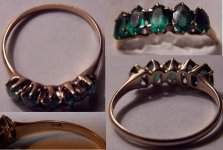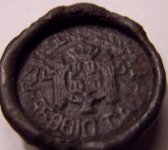j.d. in the usa
Bronze Member
- Sep 21, 2003
- 1,306
- 684
- 🥇 Banner finds
- 1
- Detector(s) used
- DFX 300
- Primary Interest:
- All Treasure Hunting
Hi everyone, I found this ring on a 300 yr. old estate. I was walking between a lane of large oak trees, I found a crotal bell at 1 in. and was excited since it was my first... I walked about another 2 ft. and got a dime signal 3in. down I dug and found a 1773 spanish 1/2 reale, as I stood up I went back over the hole with my detector and it bounced back between button and quarter at 6in. depth in the same whole, I started to dig and hit 2 large tree roots I dug under the root and out popped the ring 3in. lower in the same whole than the reale, it was very encrusted with dirt and at first I thought it was a button but the dirt came off easy and I saw it was a gold ring I turned it around and there was sunlight going through the trees and when it hit the emeralds they just shined I also found a royal Spanish seal nearby.
I took it to 2 jewelers, the first said it couldnt be old because the emeralds were fake, but they were the best fakes he's ever seen. about 2 days later he called me back and offered me $100.00 for the ring because he wanted to show his apprentices a good quality fake.
The second said it was real and old and very rare because of the marque cut emeralds he said the marking on it was a hallmark and he could tell me the makers name that they didnt use karats when it was made, but thats all the info I got he wanted me to pay $500.00 to give me an official appraisal and info. I dont have that type of money laying around so I never did it, I was cleaning my stuff and I figured I'd show it here.
I took it to an antique jewelry dealer today, at first he looked disinterested in the ring.. he then looked at it under a microscope for about 10 min. it was driving me nuts lol lol, he then did 2 tests on it with some chemicals he was very scientific about it... after about 20 min... he walks over to us and says "I hope you have a safety deposit box, what you have here is real spanish treasure". and he told me the emeralds were real and of very high quality and color and it has 56 facets.. he then pulled out a book and tracked down the hallmark it was made in spain between 1760-1795, then he gave me this info, The 18th Century was a period of great change for the manufacturers of jewelry, for at the turn of the century, a Venetian Lapidary named Vincenzo Peruzzi invented the 56 faceted brilliant cut for stones which is still used today. It replaced the duller 16 faceted Mazarin cut of the previous century and launched diamonds to the forefront of jewelry design for the next 100 years. Metal work receded into the background almost completely and metals were used exclusively as inconspicuous back settings for diamonds, emeralds, rubies, and sapphires.
The amount they charge for a written appraisal is astronomical!! I have no intention of selling it, needless to say we went and bought a safe today and my kids are already fighting over who's gonna inherit it. lol lol hh all jd
the pics are of the ring and the royal spansh seal....
Now is it 100% I personally cant say... I was told it was fake and I was told it was old... I want to beleive it is old and real spanish treasure!!
I took it to 2 jewelers, the first said it couldnt be old because the emeralds were fake, but they were the best fakes he's ever seen. about 2 days later he called me back and offered me $100.00 for the ring because he wanted to show his apprentices a good quality fake.
The second said it was real and old and very rare because of the marque cut emeralds he said the marking on it was a hallmark and he could tell me the makers name that they didnt use karats when it was made, but thats all the info I got he wanted me to pay $500.00 to give me an official appraisal and info. I dont have that type of money laying around so I never did it, I was cleaning my stuff and I figured I'd show it here.
I took it to an antique jewelry dealer today, at first he looked disinterested in the ring.. he then looked at it under a microscope for about 10 min. it was driving me nuts lol lol, he then did 2 tests on it with some chemicals he was very scientific about it... after about 20 min... he walks over to us and says "I hope you have a safety deposit box, what you have here is real spanish treasure". and he told me the emeralds were real and of very high quality and color and it has 56 facets.. he then pulled out a book and tracked down the hallmark it was made in spain between 1760-1795, then he gave me this info, The 18th Century was a period of great change for the manufacturers of jewelry, for at the turn of the century, a Venetian Lapidary named Vincenzo Peruzzi invented the 56 faceted brilliant cut for stones which is still used today. It replaced the duller 16 faceted Mazarin cut of the previous century and launched diamonds to the forefront of jewelry design for the next 100 years. Metal work receded into the background almost completely and metals were used exclusively as inconspicuous back settings for diamonds, emeralds, rubies, and sapphires.
The amount they charge for a written appraisal is astronomical!! I have no intention of selling it, needless to say we went and bought a safe today and my kids are already fighting over who's gonna inherit it. lol lol hh all jd
the pics are of the ring and the royal spansh seal....
Now is it 100% I personally cant say... I was told it was fake and I was told it was old... I want to beleive it is old and real spanish treasure!!
Amazon Forum Fav 👍
Attachments
Upvote
1





 that emerald ring was the first ring I found I would have been happy if it was just 10 years old
that emerald ring was the first ring I found I would have been happy if it was just 10 years old  Ya'll are asume
Ya'll are asume




